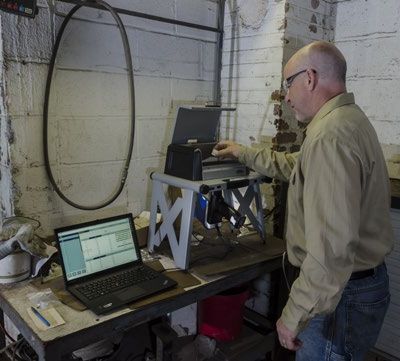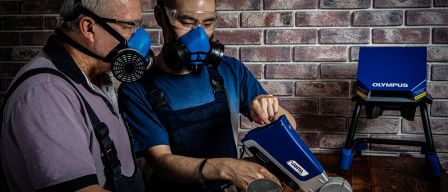Platinum (Pt), Palladium (Pd), and Rhodium (Rh) Analysis with Vanta Handheld XRF
Value
The Vanta™ handheld XRF analyzer provides quick and accurate measurement of platinum (Pt), palladium (Pd), and rhodium (Rh) in catalytic converter material. The accurate identification of these metals is vital since they are extremely valuable.
Economics
Commercially, being able to recycle the platinum group metals (PGM) helps satisfy new demand. Car catalytic converters account for more than half the demand for platinum and palladium and the bulk of rhodium demand. Knowing the PGM content of catalyst material is vital for recyclers to be able to price their material correctly.

Catalyst converters’ internal ceramic honeycomb structures are coated with a washcoat that contains Pt, Pd, and Rh. Other elements may also be present to benefit the catalytic converter.
Along with accurate measurement of Pt, Pd, and Rh concentrations, the Vanta analyzer’s element suite covers several other elements commonly added to washcoats. To help protect against fraud, Olympus has also included elements that individuals can add to catalyst materials to falsely boost precious metals values.
|
Reliable results
The reference standard samples tested have been crushed, dried, and sieved to a constant size, homogenized, and presented to the analyzer in cups with a 4 μm Prolene® film. For accurate and representative results, sample preparation is required. Trying to analyze the surface of a ceramic honeycomb can produce misleading results.
Thirty samples were tested for 60 seconds per test for Vanta models VLW, VCW, and VCA. Excellent correlation was achieved for all models. The correlation was maintained even though the samples consisted of varied matrices with a wide range of other elements. VLW results are presented below.
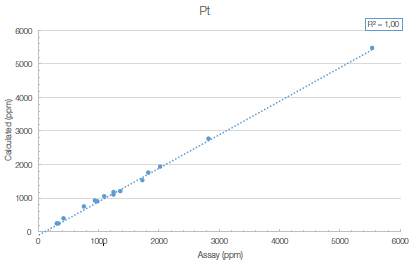
The Vanta model VLW shows good correlation with assayed values for Pt
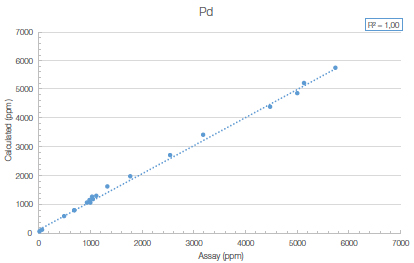
The Vanta model VLW shows good correlation with assayed values for Pd
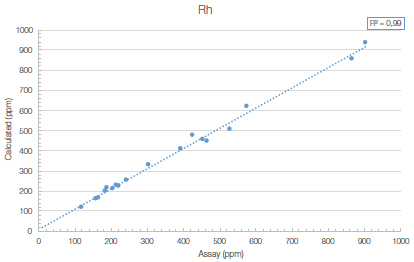
The Vanta model VLW shows good correlation with assayed values for Rh
Precision
The most significant difference among the models is in the uncertainty value, or precision, for each reading. The VLW model has a cost-effective Si-PiN detector and lower count rate than the two C series models. The result is a correspondingly larger uncertainty (+/-) value. The silicon drift detector (SDD) detector in the VCW and VCA models have higher count rates and lower uncertainties. The results also indicate that that the VCW outperforms the VCA. This is attributed to the tungsten anode of the VCW model having superior excitation to the VCA model’s silver anode.
| VLW | VCW | VCA | |||||
| Sample | Element | Reading | +/- | Reading | +/- | Reading | +/- |
| 1 | Pt | 739 | 32 | 751 | 9 | 747 | 11 |
| Pd | 1027 | 19 | 1030 | 6 | 1015 | 8 | |
| Rh | 210 | 10 | 217 | 3 | 209 | 5 | |
| 2 | Pt | 1742 | 45 | 1778 | 13 | 1752 | 16 |
| Pd | 773 | 15 | 772 | 5 | 745 | 6 | |
| Rh | 197 | 9 | 204 | 3 | 189 | 4 | |
| 3 | Pt | 251 | 29 | 261 | 8 | 298 | 11 |
| Pd | 4837 | 100 | 4944 | 31 | 4821 | 37 | |
| Rh | 857 | 24 | 839 | 7 | 846 | 10 | |
Benefits
The Vanta analyzer is an excellent tool for determining the amount of Pt, Pd, and Rh in prepared car catalyst samples. The high value of the platinum group elements makes an accurate determination of these elements commercially important.
The VCW has the best precision and is the preferred model for analysis of car catalysts. The VCA is a capable analyzer for those who also desire alloy analysis with light elements. The VLW is an excellent, cost-effective tool for basic analysis of Pt, Pd, and Rh in car catalyst material.
